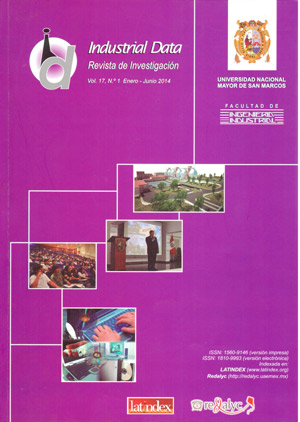Evaluación de la actividad proteolítica y lipolítica de cepas para el tratamiento de efluentes de curtiembre
DOI:
https://doi.org/10.15381/idata.v17i1.12034Palabras clave:
alcalino, bioconversión, curtiembre, efluente, lipolítico, proteolíticoResumen
Los efluentes investigados poseen una elevada DBO (Demanda Bioquímica de Oxígeno) representada principalmente por proteínas y lípidos; lo cual motivó la búsqueda de microorganismos con capacidades proteolíticas y lipolíticas, para un potencial tratamiento biológico de dichos efluentes. Se seleccionaron 39 cepas para los ensayos, de estas, el 41% resultaron positivas para actividad proteolítica, 51% para actividad lipolítica y 38% para ambas actividades; asimismo el 100% crecieron en pH 9 y 10, el 79.5% en pH 11 y el 54% en pH 12. Cabe resaltar que del total de cepas ensayadas dos de ellas (N3D y N4E) presentaron las mejores actividades proteolíticas y lipolíticas respectivamente. Se concluye que en los efluentes de curtiembre existen microorganismos con un alto potencial enzimático de bioconversión.Descargas
Descargas
Publicado
Número
Sección
Licencia
Derechos de autor 2014 Mario Alcarraz Curi

Esta obra está bajo una licencia internacional Creative Commons Atribución-NoComercial-CompartirIgual 4.0.
LOS AUTORES RETIENEN SUS DERECHOS:
a. Los autores retienen sus derechos de marca y patente, y tambien sobre cualquier proceso o procedimiento descrito en el artículo.
b. Los autores retienen el derecho de compartir, copiar, distribuir, ejecutar y comunicar públicamente el articulo publicado en la revista INDUSTRIAL DATA (por ejemplo, colocarlo en un repositorio institucional o publicarlo en un libro), con un reconocimiento de su publicación inicial en la revista INDUSTRIAL DATA.
c. Los autores retienen el derecho a hacer una posterior publicación de su trabajo, de utilizar el artículo o cualquier parte de aquel (por ejemplo: una compilación de sus trabajos, notas para conferencias, tesis, o para un libro), siempre que indiquen la fuente de publicación (autores del trabajo, revista, volumen, numero y fecha).






